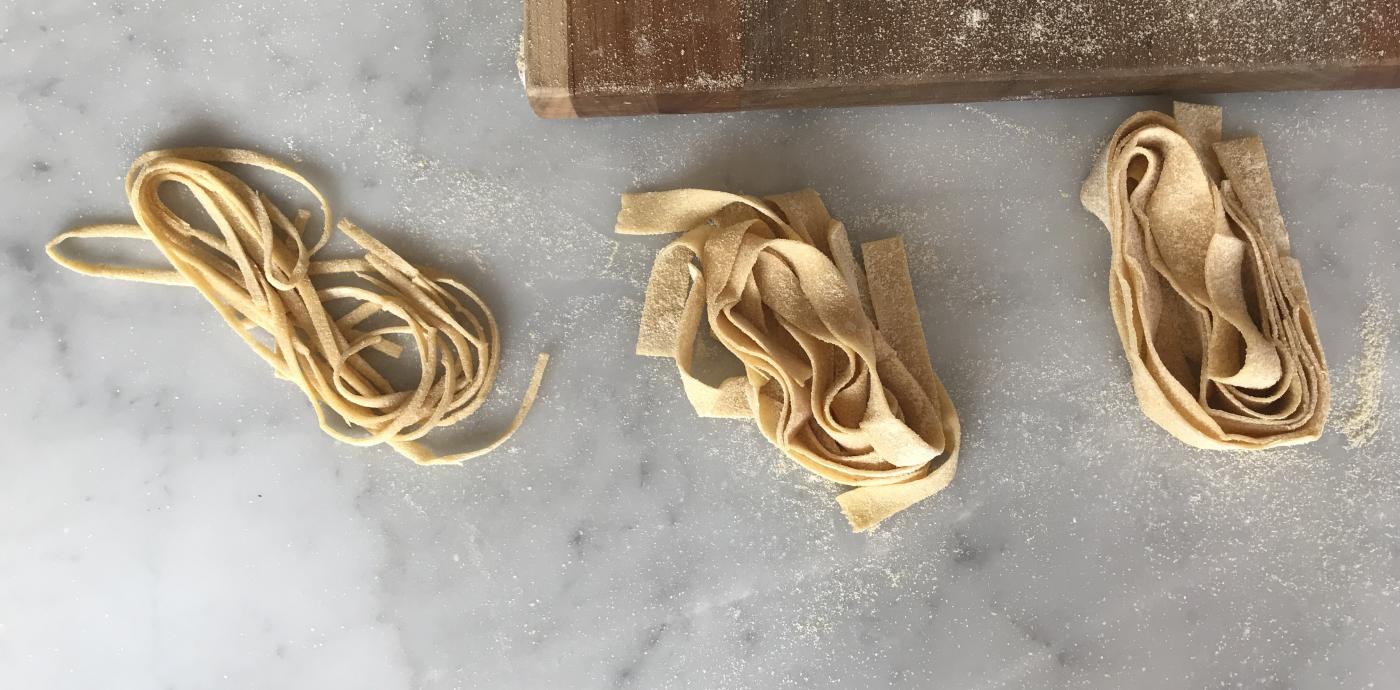October 25 is World Pasta Day. This celebration was established in 1995, when 40 pasta producers from around the globe gathered to hold the first World Pasta Congress. For nearly a quarter century, the world has joined forces to celebrate this ever-versatile and highly beloved, hearty, and filling comfort food.
Pasta can be short or long, flat or tubular, floating in broth (en brodo), tossed in sauce, stuffed, or layered. At its most basic form, pasta is simply flour and water. Though typically made from durum wheat semolina, today it is quite easy to find all kinds of whole grain pastas. When the pasta dough is extruded through the dies to form the individual shapes, it compacts the starch structure, making the pasta digest more slowly in your system. For this reason, pasta is actually a low Glycemic Index food, meaning it doesn’t cause a rapid spike in your blood sugar. This is also why pasta has such a satiating effect, keeping us fuller for longer.
Fun fact: there are more than 400 unique pasta shapes. However, in Italy, pasta is as much about the sauce as it is about the pasta. The pasta should “marry” the sauce; that is, particular pasta shapes pair better with particular sauces. Generally, larger shapes work better with thick, robust sauces, whereas skinny shapes, like strands of delicate capellini and spaghetti, suit lighter sauces. Mixed with olive oil, tomato sauce, vegetables, beans, seafood or meat, the combinations of pasta and sauce are endless. There’s definitely a plate of pasta to please everyone-vegans, vegetarians, omnivores, pescatarians, and carnivores alike.
Pasta al Pomodoro, pasta with tomato sauce, (pomodoro means tomato in Italian) is a quick and easy classic Italian dish made with little more than fresh, vine-ripened tomatoes, garlic, olive oil, and fresh basil.
Penne al Arrabiata (arrabiata means “angry” in Italian) is a spicy pasta dish made from garlic, tomatoes, and dried red chili peppers cooked in olive oil. The sauce originates from the Lazio region of Rome. As the name suggests, this dish is usually served with penne or other short pasta and finished with a sprinkling of fresh parsley and/or Parmigiano-Reggiano.
Sugo all’ Amatriciana is a traditional Italian pasta sauce of guanciale (cured pork jowl), pecorino cheese from Amatrice, tomatoes, and onion.
Pasta with Pesto (Pesto alla Genovese) hails from Genova, the capital city of the Liguria region in northwest Italy. Pesto is derived from the Italian verb pestare, which means to grind or crush, traditionally with a mortar and pestle. Pesto Genovese is comprised of freshly-ground basil, extra-virgin olive oil, pine nuts, sea salt, and garlic. Many varieties also include Parmigiano-Reggiano. Trofie, a spiral-shaped pasta, which is also native to Liguria, may be pesto’s ideal partner given that its spirals are tailor-made for trapping pesto in its nooks and crannies. Then there’s the Sicilian pesto pasta dish known as pasta alla Trapanese. Instead of a basil-based pesto, the pesto is made with almonds, garlic, and tomatoes and paired with a twisted, coil-shaped pasta known as busiate.
Cacio e Pepe (cheese and pepper) is an emulsified sauce of salty sheep’s milk Pecorino Romano cheese, black pepper, and pasta cooking water. It’s typically served with a thick pasta such as spaghetti, bucatini, or tonnarelli (aka spaghetti alla chitarra, which is made using a guitar-like instrument [i.e., a chitarra].
Spaghetti or Linguine alle Vongole is Italian for “spaghetti with clams” and is a dish that is exceedingly popular throughout Italy, especially in Campania in southwest Italy.
Pasta con Le Sarde (pasta with sardines) is a classic pasta unique to Palermo, Sicily. Heavily influenced by the cooking of Arabs, who ruled Sicily more than a thousand years ago, it features long bucatini or spaghetti and a sauce made from onions, fennel, raisins, pine nuts, anchovies, sardines, and saffron. Instead of cheese, toasted and seasoned bread crumbs are sprinkled on top.
While these recipes are Italian, pasta really is a universal ingredient. It is like a canvas that accepts the flavors of any cuisine around the Mediterranean, or for that matter, around the world. All is needed is some creativity. For example, Chef Marcus Samuelsson’s book, The Soul of a New Cuisine, features a Moroccan pasta recipe with a North African flavor of hot peppers-Penne with Harissa. Or, instead of Pasta with Pesto alla Genovese, consider Pasta with Brazil Nut Pesto. A classic Greek Salad can be transformed into a healthy pasta meal as Greek Pasta Salad, or a Greek Lasagna.
And, if you want to make that perfect plate of pasta that would please any Italian nonna (“grandmother” in Italian), or any grandmother around the world, be sure to follow these important steps:
Always cook your pasta in a very large pot of salted, boiling water. Don’t cook your pasta all the way through. Rather, cook your pasta to al dente (“to the tooth”) so that it retains a little bite to it. (This also helps lesson the impact on your blood sugar.) Keep in mind that pasta will continue to cook once drained and further when finished in the sauté pan. Reserve some pasta cooking water, as the gluten and starch in the pasta water allow the noodle to adhere to the sauce. Never rinse your pasta. Lastly, finish your pasta in its sauce in a sauté pan, with some of that reserved pasta cooking water and lightly toss until the sauce coats each strand of pasta.
Happy World Pasta Day! Why not celebrate the day with a delicious, healthy pasta meal-one that features YOUR favorite ingredients.
Want biweekly Med Diet information and recipes in your Inbox? Sign up for our Fresh Fridays newsletter by clicking the Subscribe button at the bottom of this page!
Join the Make Every Day Mediterranean Club Facebook group for additional information and support.







